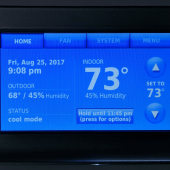Automating the comfort of your own home
I used to fight with my thermostat and heat ducts every year during season transitions. Add to that living in a two story home with the living area on the first floor, and the bedrooms on the second floor, and it's always either way too hot or way too cold in at least a few rooms of the house. Getting automated blackout blinds a few years ago helped, or at least I thought it would. The fact is unless you're constantly raising and lowering your blinds during extreme temperatures, or just keeping them closed all day and turning all the lights on, it probably won't help much.
That was all true, until Sensative Strips Comfort came along. Before that, I had thought about automating my blinds to react to extreme temperatures, but who can get a battery powered automated sensor between the blinds and the window? Well, these nifty little strips do just that...they easily and discretely fit in the tiny areas between your blinds and window, or any other place for that matter, to keep track of not only the temperature...but also the light level. Now I can rely on a few rules in my automation hub to perform the necessary actions to bring new meaning to the words "from the comfort of your own home"!
All of this depends on a few factors, such as what side of the house your windows (and automated blinds) are located on, how the sun hits them, etc. I first stood my sensor strips up near the side of the window to experiment before peeling off the sticky backing and making the installation more permanent. Then I used a device history plug-in for my automation hub to monitor the temperature and light levels over the course of a few weeks. Before that, I had no clue how many "lumens" direct sun in a certain window would yield, or how much heat was trapped between the blinds and window. The same was true for how much heat the sensor detected in that same area when the blinds were open. I also had to determine whether I wanted the sensor on the side of the window where the sun hit it directly, or the opposite side where it was out of the direct sun, but still detected the general amount of light and heat in the window area.
Once I established a history of readings to look over, then I started creating my rules. For example, in the summer, when the house is in Home mode (meaning, I'm in the house), a certain amount of light is detected by the strip, and the inside temperature subtracted from the window area temperature is less than 5 degrees, open the blinds to a pre-determined level. In my case, that's generally about 50%. If at some point the window temperature is more than 5 degrees warmer than the inside temperature (meaning it's starting to "cook" the house), lower the blinds to 10% open to still allow some light in, but keep most of the "cooking" factor out. At this point, the sun is probably brighter anyway, so 10% open should let sufficient light in. Later, as the sun starts to go down but it's still sufficiently bright outside, maybe raise the blinds back up to 50% until the sun sets.
Not only does this setup get points for the "cool" factor, it can also save you money on you air conditioning bill. Flip this thinking around for the winter and you can have your blinds raising when the sun is at it's hottest and lowering when the windows are only providing a source of extreme cold. Combine this with a few motions sensors and you can have your system turn a light on in a room where motion is sensed, at a time when not much light is coming in through the windows, or if the blinds are closed at the time.



